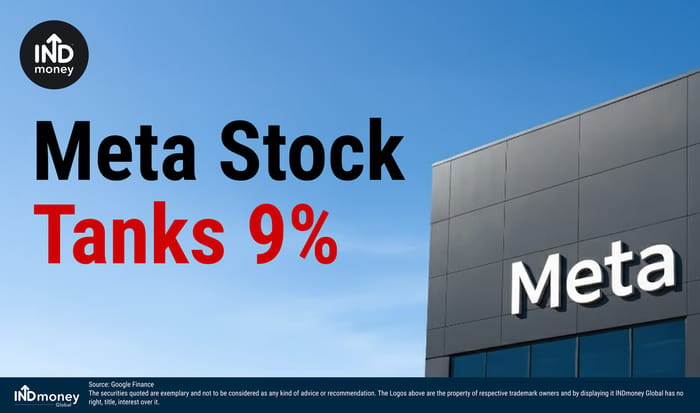
Meta’s earnings on October 29 had all the right headlines at first glance with record revenue, growing users, solid and ad demand. Yet, Meta stock fell over 9% in after-hours trading, according to Google Finance, wiping billions off its market value.
So what exactly went wrong? A mix of tax surprises, soaring AI costs, and a cautious outlook for 2026 left investors uneasy. Let’s unpack Meta’s Q3 earnings report, why Meta share price tanked and what investors should keep an eye on.
Meta Earnings Report: The Numbers Look Strong Until They Didn’t
Meta’s Q3 earnings report showed revenue of $51.2 billion, up 26% YoY, its best growth in almost three years. Daily active users across Facebook, Instagram, WhatsApp, and Threads hit 3.54 billion, a healthy 8% jump.
But the shock came at the bottom line. Meta’s Net income plunged 83%, dropping from $15.7 billion last year to just $2.7 billion this quarter. That’s not a small miss and it wasn’t because business slowed. It was because of a $15.9 billion one-time tax expense, linked to new U.S. corporate tax rules under the so-called “One Big Beautiful Bill.”
The charge is non-cash (an accounting adjustment rather than an actual payout), but it made Meta’s profit line look like a freefall. Had it not been for that, Meta’s adjusted EPS would have been $7.25 instead of the reported $1.05, a number that looks far more in line with expectations.
Why Meta Stock Tanked 9% After Earnings
Investors understand that taxes can distort numbers but that wasn’t the only red flag in Meta’s Q3 earnings report. There were three more reasons why Meta stock price slid so sharply.
1. Spending Keeps Climbing: Meta raised its capital expenditure forecast again, now expecting $70–72 billion for 2025. Most of that is going into AI infrastructure, data centers, chips, and server expansion. While long-term bets on AI make sense, it’s a huge commitment in a year when investors are asking tech giants to show profit discipline.
2. Guidance Turned Cautious: During the Meta earnings call, management flagged that expenses will continue rising in 2026 due to new hiring and higher operating costs. That warning overshadowed the strong revenue beat and reminded investors that the AI race isn’t cheap.
3. A Reality Labs Overhang: Meta’s AR/VR arm, Reality Labs, posted another $3.8 billion loss this quarter. It’s part of Zuckerberg’s long-term vision for the metaverse, but five years in, investors still don’t see clear commercial traction. Combined with the AI spending surge, that added to the perception of ballooning costs.
Meta: A Classic Case of Good Business, Bad Optics
Underneath all the noise, Meta’s core business is performing extremely well. Ad revenue is booming, thanks to better targeting tools and strong engagement on Reels and Instagram. WhatsApp’s monetization push is gaining traction too.
But the Meta stock selloff shows how markets react to optics, not just outcomes. A massive tax hit and higher spending guidance, even if strategic, were enough to shake short-term confidence. As CNBC reported, Meta’s quarter “looked worse on paper than it really was.” The numbers weren’t bad, they just weren’t reassuring.
What Investors Should Focus On
The next few quarters will determine how quickly Meta can rebuild confidence. Here’s what to watch:
- AI ROI: Meta’s AI investments must start showing visible payoffs, whether in ad performance, user growth, or new tools.
- Reality Labs Control: Losses here need to narrow; otherwise, it keeps weighing on margins.
- Tax Impact in Real Terms: This quarter’s $16 billion was non-cash, but investors will watch how actual cash tax payments evolve.
- Ad Business Momentum: Meta’s bread and butter remains advertising. Any slowdown in global ad budgets could hurt earnings growth.
The Bigger Picture for Meta
Meta is not alone in this. Big Tech is at a stage where every company is pouring billions into AI. From Nvidia to Alphabet, almost everyone is doing it, but Wall Street now wants to see profits, not just promises. Meta’s Q3 earnings highlight that tension perfectly: a company firing on all cylinders but being punished for its spending pace. It’s a reminder that in 2025, growth isn’t enough, visibility matters as well.
The 9% drop in Meta stock after earnings wasn’t about a broken business model. It was a market recalibration, a reflex reaction to taxes, cost pressures, and cautious tone. Meta’s fundamentals remain positive with steady user growth, improving ad revenue, and one of the most ambitious AI roadmaps in the industry.
But until investors see clear evidence of ROI on its massive capex, volatility will stay part of the story. As one analyst put it on CNBC, “This quarter was about narrative, not numbers.”
Disclaimer:
The content is meant for education and general information purposes only. Investments in the securities market are subject to market risks, read all the related documents carefully before investing. Past performance is not indicative of future returns. The securities quoted are exemplary and are not a recommendation. This in no way is to be construed as financial advice or a recommendation to invest in any specific stock or financial instrument. The figures mentioned in this article are indicative and for general informational purposes only. Readers are encouraged to verify the exact numbers and financial data from official sources such as company filings, earnings reports, and financial news platforms. The Company strongly encourages its users/viewers to conduct their own research, and consult with a registered financial advisor before making any investment decisions. All disputes in relation to the content would not have access to an exchange investor redressal forum or arbitration mechanism. Registered office address: Office No. 507, 5th Floor, Pragya II, Block 15-C1, Zone-1, Road No. 11, Processing Area, GIFT SEZ, GIFT City, Gandhinagar – 382355.